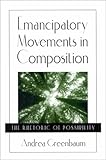 Emancipatory Movements in Composition: The Rhetoric of Possibility by Andrea Greenbaum
Emancipatory Movements in Composition: The Rhetoric of Possibility by Andrea Greenbaum
My review
rating: 2 of 5 stars
As I read Greenbaum’s Emancipatory Movements in Composition, I was struck with a problem of genre and purpose. I picked up the book expected a new argument that would offer me new insights, but instead I found a book that largely synthesized movements in composition students. Greenbaum does have somethings to add to the conversation, especially around “Bitch” pedagogy and her own experiences dealing with race in the classroom, but largely, I found this book to be more of an overview of (aspects of) the field. As reviewer Barbara Schneider put it in her CCC review, this book is great for new graduate students looking for an introduction to how cultural studies, sophist rhetoric, feminism, and postcolonialism have been integrated into composition studies.
But, like Schneider, I found the research and ideas to be too thin. I was struck that while Greenbaum discusses sophist rhetoric, she quotes Protagoras’s belief that rhetoric makes one a “better man,” but then doesn’t discuss the rather in-depth argument between Socrates and the Sophists about what makes one a better man. For a book so concerned with ethics and justice, this seemed like an missed opportunity. Additionally, the term “justice” seems used rather unproblematically, especially if we remember that many Sophists described justice as a matter of strength and might.
I enjoyed Greenbaum’s polemical take, and her frank honesty with racism in her classroom and her stance that we need, for the sake of women, agonistic rhetoric were refreshing and helpful. The book is ambitious, trying to synthesize four critical traditions under one umbrella, something that I admire. However, for this book to have more impact and not read like an overview of these fields, the book would have to expand beyond its 110 pages (plus preface and notes).
This could be done through more theoretically sound explication of what Greenbaum means by various terms. She spends a while at the end of the book asking “whom are we liberating and from what?” (84), concluding that this is “ideological liberation” (100). My concern, though, is the connection to her subtitle, “Rhetorics of Possibility,” and whether we shouldn’t be talking about liberation as a “freedom to” rather than a “freedom from.” Additionally, Greenbaum uses the term “liberal” to describe her and other critical pedagogues, leaving me to wonder whether she has thought through the use of this term and its various meanings. To me, the term connotes the ideology of liberalism, which, on an ontological level, seems contrary to the Freirean mission Greenbaum attempts to adopt.
With that said, I think this book has real value as an introduction to cultural studies, postcolonialism, feminism, and neo-sophistic rhetoric in composition studies. I wish I had read it a couple years ago when I was first starting in the field, and I certainly got a lot out of it reading it currently. I’m looking forward to class discussion around it.
(See also Barbara Schneider’s review in CCC 55.2 (December 2003): 369-371.)

